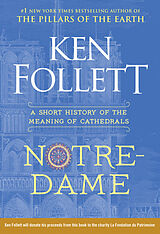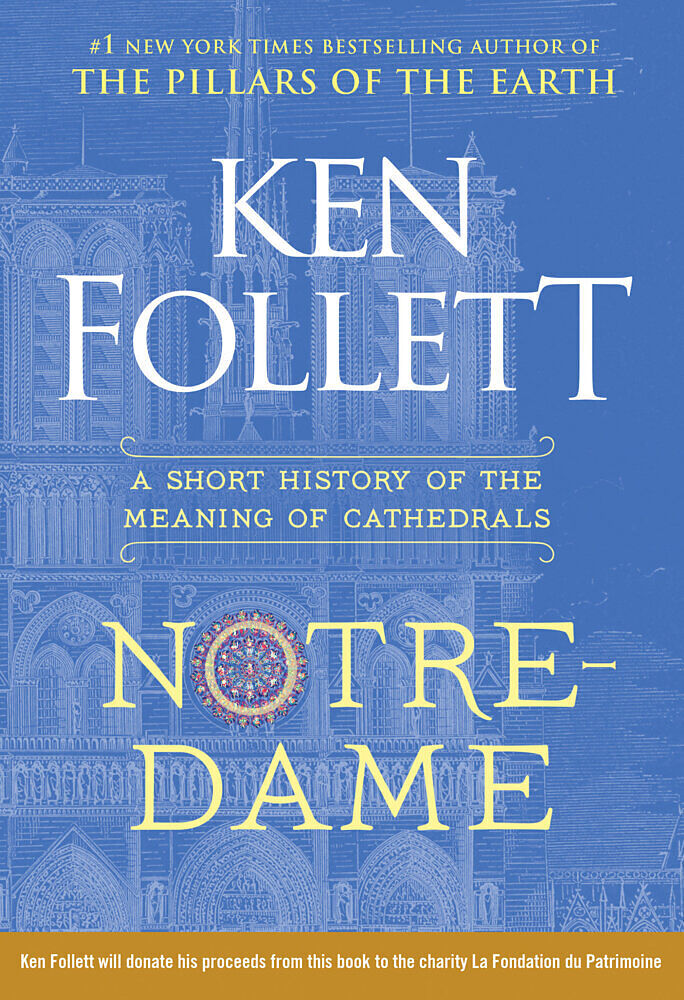Notre-Dame
Einband:
Fester Einband
EAN:
9781984880253
Untertitel:
A Short History of the Meaning of Cathedrals
Genre:
Lyrik & Dramatik
Autor:
Ken Follett
Herausgeber:
Penguin LLC US
Anzahl Seiten:
62
Erscheinungsdatum:
29.10.2019
ISBN:
198488025X
“The wonderful cathedral of Notre-Dame de Paris, one of the greatest achievements of European civilization, was on fire. The sight dazed and disturbed us profoundly. I was on the edge of tears. Something priceless was dying in front of our eyes. The feeling was bewildering, as if the earth was shaking.” --Ken Follett “[A] treasure of a book.” -- The New Yorker In this short, spellbinding book, international bestselling author Ken Follett describes the emotions that gripped him when he learned about the fire that threatened to destroy one of the greatest cathedrals in the world--the Notre-Dame de Paris. Follett then tells the story of the cathedral, from its construction to the role it has played across time and history, and he reveals the influence that the Notre-Dame had upon cathedrals around the world and on the writing of one of Follett's most famous and beloved novels, The Pillars of the Earth . Ken Follett will donate his proceeds from this book to the charity La Fondation du Patrimoine.
Praise for Notre-Dame
“Follett knows a thing or two about medieval cathedrals, having structured his Kingsbridge series around the building of one such architectural wonder . . . Fans of Follett and cathedrals alike will enjoy his exploration of the great Parisian edifice—and will want more.”
—Kirkus (starred review)
Autorentext
Ken Follett
Leseprobe
Chapter One
2019
The voice on the phone was urgent. "I'm in Paris," it said. "Turn on your television!"
I was at home, in the kitchen, with Barbara, my wife. We had just finished supper. I had not drunk any wine, which turned out to be a good thing. I did not yet know it, but the evening was going to be a long one.
The voice on the phone belonged to an old friend. She has weathered many crises as a member of Parliament and a cabinet minister, and is completely unflappable, but she sounded shocked.
You know what we saw on the screen: the wonderful cathedral of Notre-Dame de Paris, one of the greatest achievements of European civilization, was on fire.
The scene dazed and disturbed us profoundly. I was on the edge of tears. Something priceless was dying in front of our eyes. The feeling was bewildering, as if the earth was shaking.
I know the building well. One Christmas Barbara and I went to midnight Mass there. Thousands of people thronged the church. The dim lights cast deep shadows in the aisles, the carols echoed in the nave, and the vault high above us was cloaked in darkness. Most moving of all was the knowledge that our ancestors had been celebrating Christmas this way in this building for more than eight hundred years.
I had visited the church many other times. My earliest sight of it had been in 1966, on my first holiday outside the UK; although at the age of seventeen I'm afraid I was too interested in the girls in our group to pay serious attention to a cathedral. My last had been only four weeks earlier, when I had driven along the Left Bank and, as always, had drunk in the magnificent view of the twin towers and the flying buttresses.
As soon as I began to think rationally about what I was seeing on television I understood what was burning and how the fire was gathering force, but the journalists commenting did not-and why should they? They had not studied the construction of Gothic cathedrals. I had, in doing research for The Pillars of the Earth, my novel about the building of a fictional medieval cathedral. A key scene in chapter four describes the old cathedral of Kingsbridge burning down, and I had asked myself: Exactly how does a great stone church catch fire?
I had climbed into the dusty spaces under the roofs of cathedrals including Canterbury and Florence. I had stood on the mighty beams that spanned the naves and looked at the rafters that supported the lead roof tiles. I had noticed the dried-up debris that often gathers in such places: old bits of wood and rope, sandwich wrappers left by maintenance workers, the knitted twigs of birds' nests, and the papery homes of wasps. I felt sure that the fire had started somewhere in the roof, probably when a dropped cigarette or a spark from an electrical fault ignited some litter, which in turn had set the timbers ablaze. And the damage resulting from that threatened to flatten the building.
I decided to share this thought with others, so I tweeted:
The rafters consist of hundreds of tons of wood, old and very dry. When that burns the roof collapses, then the falling debris destroys the vaulted ceiling, which also falls and destroys the mighty stone pillars that are holding the whole thing up.
That turned out to be about right, except that I underestimated the strength of the pillars and the vaults, both of which were damaged but, happily, not completely obliterated.
Here's how the destruction of Kingsbridge Cathedral happened in Pillars, seen from the point of view of Prior Philip:
A crashing sound made him look up. Immediately above him, an enormous timber was moving slowly sideways. It was going to fall on top of him. He dashed back into the south transept, where Cuthbert stood looking scared. A whole section of the roof, three triangles of beam-and-rafter plus the lead sheets nailed to them, was falling in. Philip and Cuthbert watched, transfixed, quite forgetting their own safety. The roof fell on one of the big round arches of the crossing. The enormous weight of the falling wood and lead cracked the stonework of the arch with a prolonged explosive sound like thunder. Everything happened slowly: the beams fell slowly, the arch broke up slowly, and the smashed masonry fell slowly through the air. More roof beams came free, and then, with a noise like a long slow peal of thunder, a whole section of the north wall of the chancel shuddered and slid sideways into the north transept. Philip was appalled. The sight of such a mighty building being destroyed was strangely shocking. It was like watching a mountain fall down or a river run dry: he had never really thought it could happen. He could hardly believe his eyes.
As night fell on April 15, 2019, the people of Paris came out into the streets, and the television cameras showed thousands of grief-stricken faces lit by the flames, some singing hymns, others just weeping as they watched their beloved cathedral burn. The tweet that got the most heartfelt response from my followers that night just said:
Francais, francaises, nous partagons votre tristesse.
Frenchmen, Frenchwomen, we share your sadness.
It should have been "nous partageons" with an e but no one minded.
There are people who understand more about medieval cathedrals than I do, but the journalists don't know their names. They know mine because of my books, and they know that Pillars is about a cathedral, so within a few minutes I started to get messages from the newsrooms. I spent that evening doing television, radio, and press interviews, explaining in English and French what was happening on the ële de la CitŽ.
At the same time as giving interviews I was watching.
The central spire, slender as an arrowhead and 300 feet high, was a possible starting point of the fire, and now it was blazing infernally. It was made of 500 tons of oak beams with a lead roof weighing 250 tons, and the burning wood rapidly became too weak to support the burden of all that lead. The most heart-stopping moment of the evening, for the grieving crowds on the streets and the horrified millions watching television, came when the spire leaned sideways, snapped like a matchstick, and crashed through the flaming roof of the nave.
Notre-Dame had always seemed eternal, and the medieval builders certainly thought it would last until the Day of Judgment; …

Leider konnten wir für diesen Artikel keine Preise ermitteln ...
billigbuch.ch sucht jetzt für Sie die besten Angebote ...
Die aktuellen Verkaufspreise von 6 Onlineshops werden in Realtime abgefragt.
Sie können das gewünschte Produkt anschliessend direkt beim Anbieter Ihrer Wahl bestellen.
Loading...
Die aktuellen Verkaufspreise von 6 Onlineshops werden in Realtime abgefragt.
Sie können das gewünschte Produkt anschliessend direkt beim Anbieter Ihrer Wahl bestellen.
| # | Onlineshop | Preis CHF | Versand CHF | Total CHF | ||
|---|---|---|---|---|---|---|
| 1 | Seller | 0.00 | 0.00 | 0.00 |
